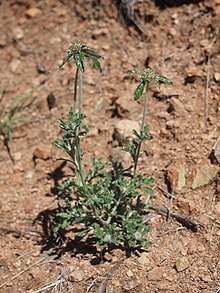Euchiton sphaericus
Euchiton sphaericus (star cudweed, tropical creeping cudweed) is a herb native to Australia, New Zealand, New Caledonia, Taiwan, Java, and Philippines. It has become naturalized in a few places in the United States (Hawaii, California, Oregon).[2][3]
| Euchiton sphaericus | |
|---|---|
 | |
| A Euchiton sphaericus plant | |
| Scientific classification | |
| Kingdom: | |
| (unranked): | |
| (unranked): | |
| (unranked): | |
| Order: | |
| Family: | |
| Genus: | |
| Species: | E. sphaericus |
| Binomial name | |
| Euchiton sphaericus (Willd.) Holub 1991 | |
| Synonyms[1] | |
| |
Description
Euchiton sphaericus grows as an erect annual herb up to 80 centimetres (32 inches) high, forming a taproot. Stems are covered with white woolly hairs. Leaves are green and hairless above, white and woolly underneath. The plant produces spherical clusters of flower heads. Heads have yellow, cream or brown flowers.[2][4]
Taxonomy
The species was first published as Gnaphalium sphaericum by Carl Ludwig Willdenow in 1809. In 1838 Augustin Pyramus de Candolle demoted it to a variety of Gnaphalium involucratum (now Euchiton involucratus) as Gnaphalium involucratum var. simplex, but this was not upheld. In 1974 Josef Holub transferred it into Euchiton.[5]
Distribution and habitat
Euchiton sphaericus is widespread in Australia, occurring in all 6 states plus Northern Territory and Norfolk Island.[6][7]
References
- The Plant List, Euchiton sphaericus (Willd.) Holub
- Floria of North America, Euchiton sphaericus (Willdenow) Anderberg, 1991. Star-cudweed
- Biota of North America Program 2014 distribution map
- "Euchiton sphaericus (Willd.) Holub". FloraBase. Western Australian Government Department of Parks and Wildlife.
- "Euchiton sphaericus (Willd.) Holub". Australian Plant Name Index (APNI), IBIS database. Centre for Plant Biodiversity Research, Australian Government.
- (Willd.) Holub. "New South Wales Flora Online: Euchiton sphaericus". Royal Botanic Gardens & Domain Trust, Sydney, Australia.
- Atlas of Living Australia, Euchiton sphaericus (Willd.) Holub, Star Cudweed